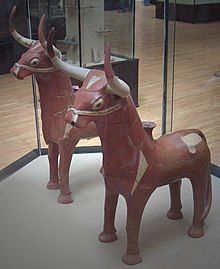Šeri and Ḫurri

Šeri and Ḫurri are two divine bulls that pull the chariot of the Hurrian weather god Teššub . In the Ullikummi song they are called Šerišu and Tilla. In Teššub's kaluti victim lists , they are named after Šarruma and in front of the Namni and Ḫazzi mountains . It is disputed whether the two bull people carrying the sky in the Hittite rock sanctuary Yazılıkaya represent Šeri and Ḫurri. Bull dyads are already in the 3rd millennium BC. Attested for Anatolia and Mesopotamia .
The names of the two bulls can also be found in a list of sacrifices for mountain gods at the ḫišuwa festival , where the mountains Šera and Šinatilla are named one after the other. The latter name contains the Hurrian numeral šina “two”, meaning “two Tilla bulls”. The location of the two mountains is unknown, but must be looked for in the Taurus or Amanos . The name of Šeri / Šerišu possibly belongs to Hurrian šerše "throne" and Ḫurri is placed in Urartian ḫurrišḫe "irrigator", which reflects the two aspects of the weather god as the god king and rain giver.
literature
- Volkert Haas : History of the Hittite religion (= Handbook of Oriental Studies . Volume 1.15). Brill, Leiden 1994, ISBN 978-9-004-09799-5 .
Individual evidence
- ↑ Volkert Haas: History of the Hittite Religion ; BTE 1.15. Brill 1994, ISBN 978-9-004-09799-5 . P. 319